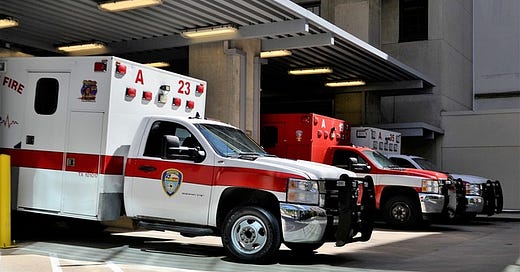How Would You Improve the Hospital Emergency Room?
Even a little improvement can make a big difference.
I spent another night in the Emergency Room with my father after he fell. I arrived last Sunday evening in the ER at about 10:30 p.m. and then spent the next five hours with him until he moved to a hospital room. (He fractured his pelvis.)
Each time I’m in the ER, I marvel at its horribleness. It’s chaotic, disorganized, unpleasant. I wonder how this kind of environment impacts the employees. I understand how it affects me and my carees (my dad and my mom until she died last August).
On Sunday night while my dad had x-rays and a CT scan, I looked at the walls with chipped paint, the floors with paper scraps, the tables with left-over supply wrappers from the previous patients. I sat on an uncomfortable chair. I watched staff get ready to care for a trauma patient to arrive via ambulance. I listened to other patients moan and cry out.
I wondered how a busy department, like an ER, could even get a break from its critical work in order to receive a make-over. But it needs one.
How can we improve the ER environment?
Some thoughts and ideas:
Have recliners available for family members. Perhaps not every cubicle will be large enough for a recliner but we need to rest. We can close our eyes when our caree is getting an x-ray or sleeping.
Have a simple coffee station, with crackers and granola bars, in a corner with a colorful sign that family members can easily see.
Have a map of areas in the hospital where a caree might go for x-rays, MRIs or CT-scans. Even if we can’t go with, it’s helpful to know where our caree is.
Post a list of physicians and staff currently working a shift who could help us. I always feel like I’m wading through a sea of professionals trying to find the nurse or doctor who is taking care of my caree. Just having a name can help.
Have a flyer posted with caregiving resources — both in the community and online — in each cubicle so family caregivers can connect to support.
Post suggestions of what we can do when the ER is crowded or in the midst of admitting a trauma patient. For instance, I would feel better if I had some guidance of how to manage when staff rushes to help a patient who needs critical care. Honestly, just the acknowledgement that we’ll see and experience trauma will be really helpful. Perhaps a poster offers a simple explanation about what we might see, such as staff performing life-saving procedures, and how this may affect staff availability for our caree. (“Ask for help by going to the nurses station so that staff can help as soon as possible. If your own family member experiences a sudden change in condition, then do XYZ.”) Insights about what we can do when we see a patient in trauma would be comforting. (Suggestions could be: Give the staff space, close your curtain, say a prayer for the patient and staff.)
Offer information on how to request a visit from a chaplain and how to find a worship space in the hospital.
Have instructions in each cubicle so that family members:
can easily access extra blankets (my parents always need extra blankets).
can find their way to the cafeteria if needed.
can locate any lounges or outdoor gardens they can use for phone calls or a break or rest.
My list is just a start.
How would you improve the Emergency Room environment?
Resources
On July 10, we’re releasing a comforting tool family caregivers can use during an ER visit. The ER Observational Assessment asks family caregivers to share their experiences so they can release the impact.
During our terrible times, we lose so much, especially our insights about the skills we master to get us through that terrible time. Join me on June 24 at 11 a.m. ET to turn the table on our terrible times by tapping into our expertise.
Join us for our next workshop, Healing the Life-Long Family Rifts, on June 27 at 1 p.m. ET.
We met on June 14 to honor the most recent winners of The Caring Award. Meet the winners of the Caregiving Programs, Caring Leaders and Grief Support Program categories.





I love this list and it's helpful not just for caregivers, but should also help ER staff by helping guide care partners to help themselves as well as their carees. The more information about what to expect and where to find things the better.
Our biggest concern now is with the elephant in the room so few want to acknowledge: COVID is still with us (both acute and long-COVID). Where I live we are experiencing staffing, bed and resources shortages. Some ERs are routinely closed and wait times can exceed 24 hours in major centers. In this environment our Public Health Officer has removed masking in hospitals which is adding to the problem and people are avoiding healthcare (1 in 5 don't even have a doctor) until problems are more serious than they need to be. That adds chaos to an already distressed system. So I'd add mandatory masking in ERs to my wish list.